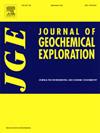Global distribution and sources of uranium and fluoride in groundwater: A comprehensive review
IF 3.4
2区 地球科学
Q1 GEOCHEMISTRY & GEOPHYSICS
引用次数: 0
Abstract
Contamination of elements in water due to geogenic and anthropogenic activities is common around the world. Intake of contaminated water causes severe health hazards to the living community. To avoid the health hazards, World Health Organisation (WHO) has specified certain limit of the level of elements as well as ions present in the water for drinking purpose. Some common chemical contaminates in the groundwater are Uranium (U) and Fluoride (Fˉ). The intake of groundwater which is having excess amount of Uranium (U) and Fluoride (Fˉ) may lead to serious health issues. The permissible level of Uranium in water as is 30 ppb as per WHO, but in some regions due to the rock type, mining activity, chemical waste; the level of U present in water might be higher than the prescribed limit and its consumption may cause carcinogenic and non-carcinogenic diseases. As like Uranium, Fluoride has certain limit fixed by WHO that is 1.5 ppm. If the level of Fˉ is higher than 1.5 ppm it may cause dental fluorosis and skeletal fluorosis. To reduce the health risks due to intake of the elements or ions, the contaminated groundwater needs to be monitored and treated by means of constructing artificial recharge structures and other rainwater harvesting methods. However, certain ex-situ processes like membrane method, ion exchange, adsorption, and precipitation may be adopted to reduce or remove the contaminated elements/ions in the groundwater.
地下水中铀和氟的全球分布和来源:全面审查
由于地质和人为活动导致的水中元素污染在世界各地都很常见。摄入受污染的水对生活社区造成严重的健康危害。为避免对健康造成危害,世界卫生组织(世卫组织)规定了饮用水中元素和离子的含量上限。地下水中常见的化学污染物是铀(U)和氟化物(F - F)。地下水中铀(U)和氟化物(F - F)含量超标,可能导致严重的健康问题。根据世界卫生组织,水中铀的允许含量为30 ppb,但在一些地区,由于岩石类型,采矿活动,化学废物;水中的铀含量可能高于规定的限量,而饮用铀可能导致致癌和非致癌疾病。与铀一样,世界卫生组织规定的氟化物限量为百万分之1.5。如果氟离子浓度高于1.5 ppm,则可能引起氟牙症和氟骨症。为了减少因摄入元素或离子而造成的健康风险,需要通过建造人工补给结构和其他雨水收集方法对受污染的地下水进行监测和处理。但是,可以采用膜法、离子交换、吸附、沉淀等非原位处理方法来减少或去除地下水中的污染元素/离子。
本文章由计算机程序翻译,如有差异,请以英文原文为准。
求助全文
约1分钟内获得全文
求助全文
来源期刊

Journal of Geochemical Exploration
地学-地球化学与地球物理
CiteScore
7.40
自引率
7.70%
发文量
148
审稿时长
8.1 months
期刊介绍:
Journal of Geochemical Exploration is mostly dedicated to publication of original studies in exploration and environmental geochemistry and related topics.
Contributions considered of prevalent interest for the journal include researches based on the application of innovative methods to:
define the genesis and the evolution of mineral deposits including transfer of elements in large-scale mineralized areas.
analyze complex systems at the boundaries between bio-geochemistry, metal transport and mineral accumulation.
evaluate effects of historical mining activities on the surface environment.
trace pollutant sources and define their fate and transport models in the near-surface and surface environments involving solid, fluid and aerial matrices.
assess and quantify natural and technogenic radioactivity in the environment.
determine geochemical anomalies and set baseline reference values using compositional data analysis, multivariate statistics and geo-spatial analysis.
assess the impacts of anthropogenic contamination on ecosystems and human health at local and regional scale to prioritize and classify risks through deterministic and stochastic approaches.
Papers dedicated to the presentation of newly developed methods in analytical geochemistry to be applied in the field or in laboratory are also within the topics of interest for the journal.
 求助内容:
求助内容: 应助结果提醒方式:
应助结果提醒方式:


